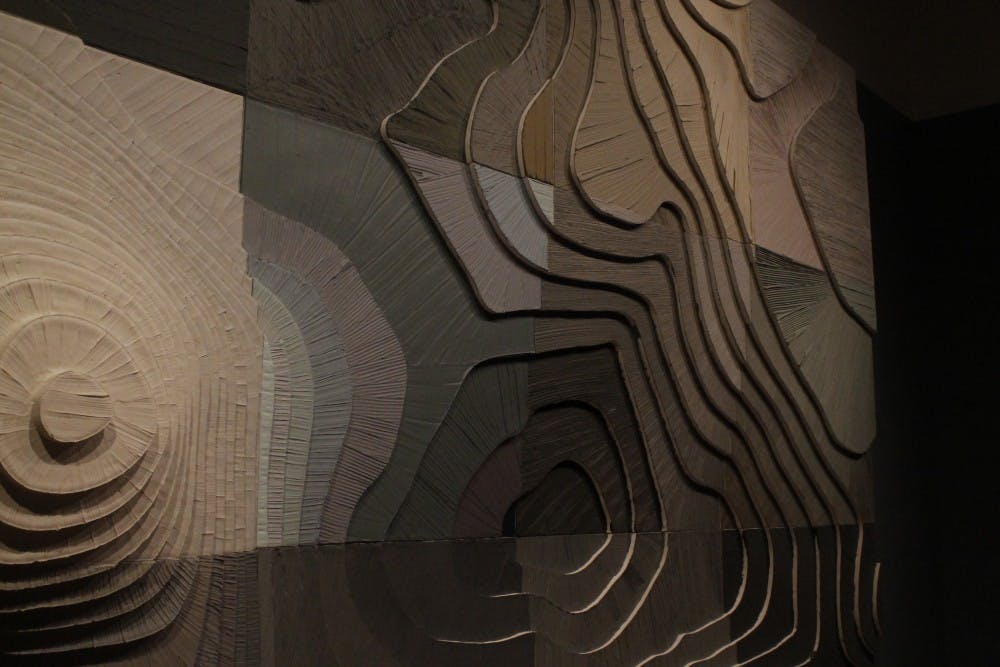‘New Cartographies’ brings a measured perspective to map-making

Maps don’t just show location in the Asia Society of Texas’ newest exhibition. “New Cartographies” showcases four artists and their exploration of the nuances associated with creating a physical representation of an entire region. In these works, the artists find new ways to create maps by incorporating the regions’ personal subjectivity, political struggles and colonial pasts.
All four artists, Sohei Nishino, Tiffany Chung, Li Songsong and Allan deSouza, have their works displayed in different rooms, giving the artists more space for their pieces and emphasizing the distinctions between each individual’s style. The silence and darkness of the gallery allow the viewer to explore the complexity of each piece and the gravity of the issues being analyzed as they travel through the rooms.
The first room features pieces by Nishino, whose work has a deep intimacy about it that pulls the viewer in. The most prominent works are collages of the New Delhi cityscape, composed of thousands of photos of city residents and architecture. These images express how Nishino views the city and its people, emphasizing the subjective lens through which an individual experiences a region.
The second artist showcased is Chung, who uses her unique perspective as a refugee to convey the realities that millions of displaced people around the world face every day. Her tireless research of cartographic methods is evident in her accurate geopolitical maps that highlight the effects of international conflicts and natural disasters. The most beautiful and haunting part of her exhibit is a series of lightboxes displaying the destruction of a city by ISIS.

The third artist, Songsong, has the most expansive piece in the exhibit. His work “Beihai” takes up the entire wall of his room and uses various palettes of muted colors to compose 15 grid squares. He depicts the White Pagoda, a notable Buddhist temple erected during the Qing Dynasty and a prominent location used by the Chinese Communist Party. By choosing a region with so much history, Songsong juxtaposes the political forces of the past and present.
The final artist showcased is deSouza. His works are structured around the novel “Through the Black Country,” which tells an account of an Indian explorer’s search for the source of the Thames River. “Through the Black Country” references earlier works, such as “Through the Dark Continent” by Henry Morton Stanley, which depicts the colonial exploration of Africa and other continents. By using a narrative that calls to attention colonial-era exploration, deSouza communicates present political issues by referencing many countries’ colonial pasts.
The Asia Society of Texas’ “New Cartographies” exhibition provides four unique perspectives on how maps can be used to express more than just the physical aspects of a region. Nishino explores the subjectivity that comes with how individuals view a city while Chung expresses how easily we forget the millions of people displaced from their homeland by political and environmental events. Songsong creates a grandiose display that juxtaposes past and present political forces, and deSouza creates works that highlight many nations’ colonial pasts. This exhibition encourages the viewer to recognize how many maps gloss over the complex issues that nations face.
“New Cartographies” is on display at the Asia Society of Texas until March 17, 2019. Admission is free for any Asia Society of Texas member and $8 for all non-members.
More from The Rice Thresher

Student-run “Sleepy Cyborg” brings abstract art to life
Tucked away in the basement of Sewall Hall is a small 10-by-12-foot gallery, with an extension in the sculpture courtyard nicknamed “the pit.” “Sleepy Cyborg,” a gallery initially started in 2009 under the name “Matchbox,” is run entirely by students, allowing student artists to experiment, curate and showcase their work outside of more formal programs.

Review: “Hurry Up Tomorrow” is a mixed bag but mostly satisfying
If “After Hours” represents death and “Dawn FM” represents purgatory, “Hurry Up Tomorrow” must signify resurrection or rebirth. It's unfortunate, then, that The Weeknd’s (born Abel Tesfaye) “rebirth” feels like a lesser version of his previous artistic selves.

Review: “Nickel Boys” is an intimate and potent masterpiece
Oscar season might have crowned Brady Corbet as the new “great American director” for his ambitiously sprawling “The Brutalist,” but with Nickel Boys — his adaptation of Colson Whitehead’s Pulitzer Prize-winning novel — RaMell Ross stuns us all, staking a bold claim as a visionary, essential voice in American filmmaking.

Please note All comments are eligible for publication by The Rice Thresher.